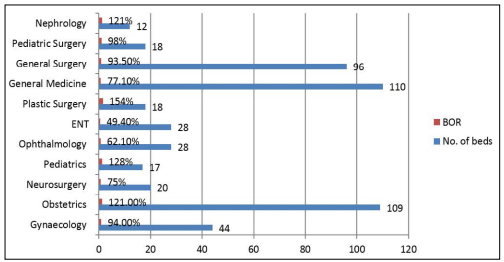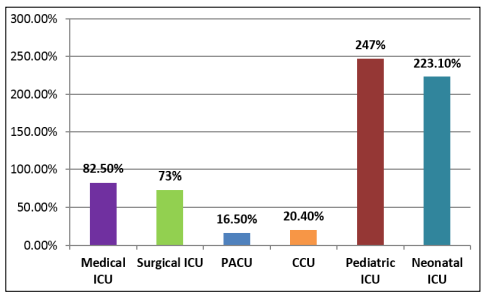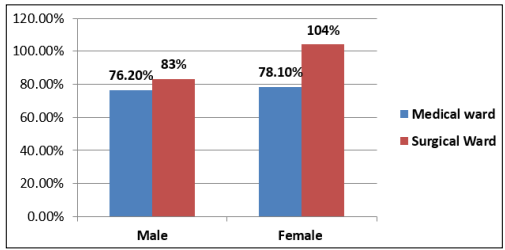Author(s): Rizwana Shahid, Farzana Fatima, Shazia Zeb and Muhammad Umar
Objective: To compare the bed occupancy rates of various departments of Holy Family Hospital during January 2022.
Materials & Methods: A cross-sectional descriptive study was done to determine and compare the Bed Occupancy Rates (BOR) of January 2022 from numerous departments of Holy Family Hospital Rawalpindi. Medicine & Allied departments in our study were those of Medicine, Nephrology and Paediatrics. Surgery and Allied departments were comprised of General Surgery, Plastic Surgery, Pediatric Surgery, Gynecology, Obstetrics, ENT, Ophthalmology and Neurosurgery. No. of beds for Medicine and Surgery & Allied departments are denoted by “n”. Data was analysed by Microsoft Excel 2010. Data was also gathered from intensive care units of the hospital. BOR% of each department and mean BOR were calculated. Difference between Mean BOR ± SD of Medicine & Allied and Surgery & Allied was statistically confirmed by applying independent sample t-test. P ≤ 0.05 was taken as significant. 95% CI
Results: Mean BOR of hospital wards was 97.6%. The greatest BOR was reported from Plastic Surgery department (154%) followed by that from Paediatrics (128%). Nephrology and Obstetrics with same BOR (121%) were ranked third. Mean BOR of Medicine & Allied departments was 108.7 ± 27.59 while that of Surgery & Allied was 93.4 ± 35.79. This difference of mean BOR was statistically significant (P = 0.000; 95% CI, 9.4 – 21.2). The crowning of BOR from Pediatric and Neonatal ICU was acknowledged with 247% and 223.10% respectively. The female patients in both medical and surgical departments were greater in magnitude than males.
Conclusion: BOR of public sector teaching hospital is quite enormous that needs attention of policy makers for diminution
Hospitals constitute a principal component of healthcare system. Occupancy of hospital beds is one of the key markers employed by hospital administrators to measure the utilization of available healthcare resources [1]. Bed occupancy rate of a hospital is an essential healthcare management indicator; its significance in decision making for provision of optimal healthcare services to the patients can never be denied [2].
Hospital beds constitute a vital and economical resource of any healthcare system [3]. Due to association of over-occupancy of hospital beds with escalated incidence of nosocomial infections [4]. Around 85% is an ideal bed occupancy rate that is recommended internationally forscientific management and smooth utilization of healthcare assets [5]. Apart from utilization of healthcare services, Bed Occupancy Rate (BOR) also reflectsthe quality of healthcare. BOR of our public sector teaching hospitals situated in Punjab reported by District Health Information System (DHIS) during 2019 was about 94% [6]. Number of hospital beds per capita has drastically been reduced in OECD countries since 2009 with more than 50% fall in Finland. Likewise Norway and Netherlands have also substantially lessened their per capita bed / 1000 population that are primarily ascribed to innovative medical procedures and performing surgeries on the day of hospital admission [7].
Surging of bed occupancy rate of healthcare facilities is determined to be positively correlated with Clostridium Difficile infection and mortality8. Hospital acquired infections due to increased length of hospital stay now being complicated with anti-microbial resistance has now become the trending topic across the globe. Discussion pertaining to the impact of bed occupancy on patient safety has drawn up worldwide [9]. The present study is therefore anticipated to oversee the bed occupancy rates across various departments and units of Holy Family Hospital Rawalpindi measured during January 2022 that being a public sector tertiary care facility is situated in the centre of Rawalpindi city. It caters the maximum patients not only from twin cities (Rawalpindi and Islamabad) but also the cases from nearby districts due to acquisition with all equipment and specialists to deal with specialized healthcare problems. Thisstudy would really prove beneficial to ourstrategic planners in perceiving the workload of the hospital staff in addition to the burden on public sector healthcare services.
A cross-sectional descriptive study was carried out to analyse the Bed Occupancy Rates (BOR) of January 2022 from numerous departments of Holy Family Hospital Rawalpindi. This is a 1000 bedded tertiary care facility that is equipped with all basic and specialized healthcare departments, telemedicine services, skill laboratories for the training of undergraduate students, postgraduate trainees, and nursing students and staff. Moreover, endoscopic ultrasonographies, laparoscopic surgeries CT scan and MRI are also carried out in this public sector teaching hospital for provision of diagnostic and treatment opportunities to the general public under one roof [10]. Data of Emergency departments was excluded from the study. BOR of each department was calculated in percentage (%) by the formula as given below: [11]

Medicine & Allied departments in our study were those of Medicine, Nephrology and Paediatrics. Surgery and Allied departments were comprised of General Surgery, Plastic Surgery, Pediatric Surgery, Gynecology, Obstetrics, ENT, Ophthalmology and Neurosurgery. No. of beds for Medicine and Surgery & Allied departments are denoted by “n”. BOR of all intensive care units was also totalled. Data was analysed by Microsoft Excel 2010. BOR% of each department and mean BOR were computed. BOR of different intensive care units were also compared. Difference between Mean BOR ± SD of Medicine & Allied and Surgery & Allied was statistically verified by means of independent sample t-test. P ≤ 0.05 was considered significant.
Bed occupancy rates of all wards were calculated for the month of January 2022. Mean BOR of hospital wards was 97.6%. The highest BOR was that of Plastic Surgery ward followed by those of Paediatrics ward. BOR against the number of available beds in each department is depicted below in Figure 1.

Figure 1: Bed Occupancy Rates (bor) & no. of Beds in Different Wards of Holy Family Hospital Rawalpindi
On reviewing the bed occupancy rates of various intensive care units of Holy Family Hospital, mean BOR was figured as 110.4%. Pediatric ICU was determined with the highest bed occupancy rate (247%) as presented below in Figure 2.

Figure 2: Bed Occupancy Rates of Intensive Care Units (ICU) During January 2022
Statistically significant difference (P < 0.000) was observed between mean BOR% ± SD of Medicine and those of Surgery & Allied departments of Holy Family Hospital Rawalpindi as illustrated below in Table 1.
Table 1: Comparison of Mean BOR% ± SD between Medical & Surgical Departments
| Mean BOR% ± SD | P-value (95% CI) | |
| Medicine & Allied (n = 139) | Surgery & Allied (n = 361) | |
| 108.7 ± 27.59 | 93.4 ± 35.79 | 0.000 (9.4 - 21.2) |
On analysing the gender based variations in bed occupancy rate of medical and surgical wards during January 2022, female beds were determined to be comparatively more occupied as reflected below in Figure 3.

Figure 3: Gender Based Comparison of BOR% in Medical and Surgical Ward
Bed occupancy rates of hospitals seem to be associated with compromised quality of healthcare [12]. There is utilization of hospital resources in managing hospital stay of the patients on their admission instead of its productive consumption in laboratory and radiological diagnosis of the patients for subsequent healthcare management [13].
The current study revealed mean bed occupancy rate in wards of Holy Family Hospital around 97.6% that is greater than standard yardstick of 80-85%. On the other hand, mean BOR in Nigerian teaching hospitals was determined to be 42.14% over a span of 6 years. One of the underlying reasons for this lower BOR in Nigeria was confrontation with serious economic disruption [14]. Similar to our results, Friebel R also documented bed occupancy rate of 90.4% during 2014-2016 in NHS trusts of England [15]. This much raised BOR is in dire need of regional policy makers to ensure provision of safe and efficient healthcare to the population. On the other hand, mean bed occupancy rate of Liaquat University Hospital Jamshoro was determined to be 51.3%. Likewise Holy Family Hospital, Liaquat University Hospital being 1300 bedded tertiary care facility is also meant to serve the maximum population of Sindh province but its BOR is within acclaimed range [16]. This difference in BOR of two national teaching hospitals that are supposed to cater the massive population residing in one country, suffering from same climatic fluctuations with almost equal predilection towards development of infectious and noncommunicable diseases is thought provoking and necessitates further research.
Of the 218 key gauges employed in numerous researches by healthcare administrators for assessing the hospital performance, BOR constitutes one of the most frequently used indicators [17]. Mean BOR of the intensive care beds at Holy Family Hospital during January 2022 was 110.4% with reporting of highest BOR% from Pediatric ICU as evident from Figure 2. Similarly mean BOR recorded NHS services were escalated from 87.7% (2011- 12) to 89.5% (2014-15) [18]. Upsurge of BOR% should direct the attention of our hospital administrators toward inclusion of more beds in the departments with increased patient load in order to meet the healthcare needs of public efficiently
BOR of Paediatrics and Obstetrics departments in present study were found to be the second (128%) and third highest (121%) respectively. The current Pakistani population (2022) of approximately 235,824,862 elucidates about 1.91% growth rate as compared to that of 2021[19]. The main reason for raised BOR in aforementioned departments is obviously increased birth rate that is primarily causing the bed shortage. A quality improvement project was recently carried out in order to address this sensitive issue pertinent to bed shortage in maternity ward of Bhutan’s referral hospital. This project offered the option of early postoperative discharge of mothers by expediting their recovery process [20]. Another study by Askari R et al during 2015 revealed patients’ satisfaction rate of 66.74% from obstetrical services of Iranian teaching hospital that had BOR of about 83% [21]. Patients’ satisfaction in correlation with bed occupancy rate of the hospital is also a significant aspect that should be studied for provision of evidencesto the decision makersfor rectification and hence betterment of the current scenario.
Bed Occupancy Rate (BOR) of the wards instituted in public sector tertiary care facility is massively high. Moreover, intensive care units particularly those of pediatric and neonatal were determined with gigantic bed occupancy rate. This needs attention of the concerned health administrators to take necessary action pertinent to rise in number of beds / expansion of the compacted wards and intensive care units for provision of necessary healthcare to the patients who primarily visit government hospitals due constrained resources.
Limitations: Data from emergency departments could not be retrieved for analysis.
Source of Funding: Nil
Conflict of Interest: None to declare
